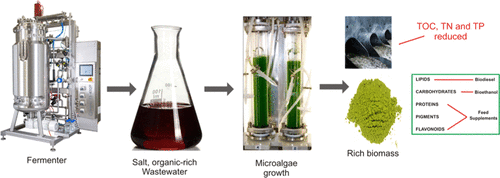当前位置:
X-MOL 学术
›
Ind. Eng. Chem. Res.
›
论文详情
Our official English website, www.x-mol.net, welcomes your feedback! (Note: you will need to create a separate account there.)
Treatment of Saline Organic-Rich Fermentation Wastewater by Marine Chlorella sp. for Value-Added Biomass Production
Industrial & Engineering Chemistry Research ( IF 4.2 ) Pub Date : 2021-09-07 , DOI: 10.1021/acs.iecr.1c01874 Muhammad Shafiq 1 , Liaqat Zeb 1 , Muhammad Jawad 1 , Zhanyou Chi 1
Industrial & Engineering Chemistry Research ( IF 4.2 ) Pub Date : 2021-09-07 , DOI: 10.1021/acs.iecr.1c01874 Muhammad Shafiq 1 , Liaqat Zeb 1 , Muhammad Jawad 1 , Zhanyou Chi 1
Affiliation

|
High-salt-concentration wastewater is an important pollution source for the ocean environment, and its ecological treatment is obligatory to meet the standard of discharge. In this study, an isolated Chlorella sp. from seawater was cultivated to treat salt organic-rich fermentation wastewater to simultaneously remove organic and inorganic nutrients. The results show that Chlorella sp. achieved the highest biomass (6.07 g/L) under a mixotrophic mode in a medium containing 50% fermentation wastewater. The removal rates of total organic carbon (TOC), ammonia-N, (NH3-N), total nitrogen (TN), and total phosphorus (TP) were 89, 95, 87, and 88%, respectively, after 10 days of cultivation. Lipid, carbohydrate, and protein contents in dry biomass were 33, 21, and 34% (w/w), respectively. Moreover, the produced biomass had 37.8 mg/g chlorophyll, 10 mg/g carotenoid, and 0.168 mg/g flavonoids. A flocculation efficiency of >90% was achieved in a medium containing 50% fermentation wastewater in 12 h of settling. The fatty acids composition analysis of the produced lipid shows that it is a suitable feedstock for biodiesel production. Taken together, mixotrophic cultivation of marine Chlorella sp. has the potential for the treatment of high salt organic-rich wastewater, as well as value-added biomass production.
中文翻译:

海洋小球藻处理含盐有机肥发酵废水。用于增值生物质生产
高盐废水是海洋环境的重要污染源,其生态处理必须达到排放标准。在这项研究中,一个孤立的小球藻。来自海水的培养用于处理富含盐分的有机发酵废水,同时去除有机和无机营养物。结果表明小球藻属。在混合营养模式下,在含有 50% 发酵废水的培养基中获得了最高的生物量 (6.07 g/L)。总有机碳(TOC)、氨氮、(NH 3-N)、总氮 (TN) 和总磷 (TP) 在培养 10 天后分别为 89、95、87 和 88%。干生物质中的脂质、碳水化合物和蛋白质含量分别为 33%、21% 和 34% (w/w)。此外,所生产的生物质含有 37.8 毫克/克的叶绿素、10 毫克/克的类胡萝卜素和 0.168 毫克/克的黄酮类化合物。在含有 50% 发酵废水的培养基中,沉降 12 小时可达到 >90% 的絮凝效率。生产的脂质的脂肪酸组成分析表明,它是生产生物柴油的合适原料。总之,海洋小球藻的混合营养培养。具有处理高盐富含有机物废水以及高附加值生物质生产的潜力。
更新日期:2021-09-22
中文翻译:

海洋小球藻处理含盐有机肥发酵废水。用于增值生物质生产
高盐废水是海洋环境的重要污染源,其生态处理必须达到排放标准。在这项研究中,一个孤立的小球藻。来自海水的培养用于处理富含盐分的有机发酵废水,同时去除有机和无机营养物。结果表明小球藻属。在混合营养模式下,在含有 50% 发酵废水的培养基中获得了最高的生物量 (6.07 g/L)。总有机碳(TOC)、氨氮、(NH 3-N)、总氮 (TN) 和总磷 (TP) 在培养 10 天后分别为 89、95、87 和 88%。干生物质中的脂质、碳水化合物和蛋白质含量分别为 33%、21% 和 34% (w/w)。此外,所生产的生物质含有 37.8 毫克/克的叶绿素、10 毫克/克的类胡萝卜素和 0.168 毫克/克的黄酮类化合物。在含有 50% 发酵废水的培养基中,沉降 12 小时可达到 >90% 的絮凝效率。生产的脂质的脂肪酸组成分析表明,它是生产生物柴油的合适原料。总之,海洋小球藻的混合营养培养。具有处理高盐富含有机物废水以及高附加值生物质生产的潜力。

























 京公网安备 11010802027423号
京公网安备 11010802027423号